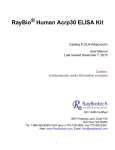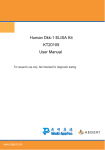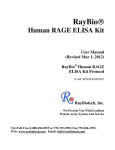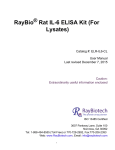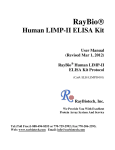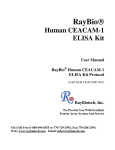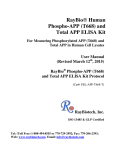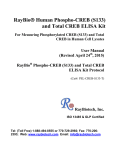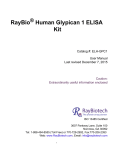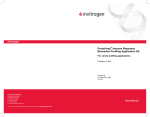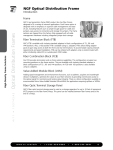Download RayBio® Human Beta
Transcript
RayBio Human Beta-NGF ELISA Kit User Manual (Revised Mar 1, 2012) RayBio Human Beta-NGF ELISA Kit Protocol (Cat#: ELH-BNGF-001) RayBiotech, Inc. We Provide You With Excellent Protein Array System And Service Tel:(Toll Free)1-888-494-8555 or 770-729-2992; Fax:770-206-2393; Web: www.raybiotech.com Email: [email protected] RayBiotech, Inc. RayBio Human Beta-NGF ELISA Kit Protocol TABLE OF CONTENTS I. Introduction……..……………………………….2 II. Reagents……………………………..…………..2 III. Storage.…………………………………………..3 IV. Additional Materials Required……………....…..3 V. Reagent Preparation………………………………3 VI. Assay Procedure…………………………………5 VII. Assay Procedure Summary……………………...6 VIII. Calculation of Results A. Typical Data…..……………………….…….…..7 B. Sensitivity……………………………….….……8 C. Recovery…………………………..……………..8 D. Linearity………………………………….…….. 8 E. Reproducibility…………………………………..8 IX. Specificity………………………………………..9 X. Troubleshooting Guide.………………………....10 RayBio Human beta-NGF ELISA Kit Protocol 1 I. INTRODUCTION The RayBio Human beta-NGF (beta-nerve growth factor) ELISA (Enzyme-Linked Immunosorbent Assay) kit is an in vitro enzyme-linked immunosorbent assay for the quantitative measurement of human beta-NGF in serum, plasma, cell culture supernatants and urine. This assay employs an antibody specific for human beta-NGF coated on a 96-well plate. Standards and samples are pipetted into the wells and beta-NGF present in a sample is bound to the wells by the immobilized antibody. The wells are washed and biotinylated anti-human beta-NGF antibody is added. After washing away unbound biotinylated antibody, HRP-conjugated streptavidin is pipetted to the wells. The wells are again washed, a TMB substrate solution is added to the wells and color develops in proportion to the amount of beta-NGF bound. The Stop Solution changes the color from blue to yellow, and the intensity of the color is measured at 450 nm. II. REAGENTS 1. Beta-NGF Microplate (Item A): 96 wells (12 strips x 8 wells) coated with anti-human beta-NGF. 2. Wash Buffer Concentrate (20x) (Item B): 25 ml of 20x concentrated solution. 3. Standards (Item C): 2 vials, recombinant human beta-NGF. 4. Assay Diluent (Item E): 15 ml of 5x concentrated buffer. For Standard/Sample (serum/plasma samples/cell culture medium/urine) diluent. 5. Detection Antibody beta-NGF (Item F): 2 vial of biotinylated antihuman beta-NGF (each vial is enough to assay half microplate). 6. HRP-Streptavidin concentrate (Item G): 200 µl 800x concentrated HRP-conjugated streptavidin. 7. TMB One-Step Substrate Reagent (Item H): 12 ml of 3,3’,5,5’tetramethylbenzidine (TMB) in buffered solution. 8. Stop Solution (Item I): 8 ml of 0.2 M sulfuric acid. RayBio Human beta-NGF ELISA Kit Protocol 2 III. STORAGE May be stored for up to 6 months at 2o to 8oC from the date of shipment. Standard (recombinant protein) should be stored at -20 oC or -80 o C (recommended at –80 oC) after reconstitution. Opened Microplate Wells or reagents may be stored for up to 1 month at 2o to 8oC. Return unused wells to the pouch containing desiccant pack, reseal along entire edge. Note: the kit can be used within one year if the whole kit is stored at -20 oC. Avoid repeated freeze-thaw cycles. IV. ADDITIONAL MATERIALS REQUIRED 1 2 3 4 5 6 7 Microplate reader capable of measuring absorbance at 450 nm. Precision pipettes to deliver 2 µl to 1 ml volumes. Adjustable 1-25 ml pipettes for reagent preparation. 100 ml and 1 liter graduated cylinders. Absorbent paper. Distilled or deionized water. Log-log graph paper or computer and software for ELISA data analysis. 8 Tubes to prepare standard or sample dilutions. V. REAGENT PREPARATION 1. Bring all reagents and samples to room temperature (18 - 25°C) before use. 2. Sample dilution: If your samples need to be diluted, 1xAssay Diluent (Item E) is used for dilution of serum/plasma/culture supernatants/urine. Suggested dilution for normal serum/plasma: 2 fold* RayBio Human beta-NGF ELISA Kit Protocol 3 *Please note that levels of the target protein may vary between different specimens. Optimal dilution factors for each sample must be determined by the investigator. 3. Assay Diluent (Item E) should be diluted 5-fold with deionized or distilled water before use. 4. Preparation of standard: Briefly spin the vial of Item C. Add 400 µl 1x Assay Diluent (Item E) into Item C vial to prepare a 50 ng/ml standard solution. Dissolve the powder thoroughly by a gentle mix. Add 50 µl beta-NGF standard from the vial of tem C, into a tube with 450 µl 1x Assay Diluent to prepare a 5,000 pg/ml standard solution. Pipette 400µl 1x Assay Diluent into each tube. Use the 5,000 pg/ml standard solution to produce a dilution series (shown below). Mix each tube thoroughly before the next transfer. 1x Assay Diluent serves as the zero standard (0 pg/ml). 50 µl standard + 450µl 5,000 pg/ml 200µl 1,667 pg/ml 200 µl 200 µl 200 µl 200 µl 200 µl 555.6 pg/ml 185.2 pg/ml 61.73 pg/ml 20.58 pg/ml 6.86 pg/ml 0 pg/ml 5. If the Wash Concentrate (20x) (Item B) contains visible crystals, warm to room temperature and mix gently until dissolved. Dilute 20 ml of Wash Buffer Concentrate into deionized or distilled water to yield 400 ml of 1x Wash Buffer. RayBio Human beta-NGF ELISA Kit Protocol 4 6. Briefly spin the Detection Antibody vial (Item F) before use. Add 100 µl of 1x Assay Diluent into the vial to prepare a detection antibody concentrate. Pipette up and down to mix gently (the concentrate can be stored at 4°C for 5 days). The detection antibody concentrate should be diluted 80-fold with 1x Assay Diluent and used in step 4 of Part VI Assay Procedure. 7. Briefly spin the HRP-Streptavidin concentrate vial (Item G) and pipette up and down to mix gently before use. HRP-Streptavidin concentrate should be diluted 800-fold with 1x Assay Diluent. For example: Briefly spin the vial (Item G) and pipette up and down to mix gently . Add 15 µl of HRP-Streptavidin concentrate into a tube with 12 ml 1x Assay Diluent to prepare a final 800 fold diluted HRP-Streptavidin solution (don’t store the diluted solution for next day use). Mix well. VI. ASSAY PROCEDURE: 1. Bring all reagents and samples to room temperature (18 - 25°C) before use. It is recommended that all standards and samples be run at least in duplicate. 2. Add 100 µl of each standard (see Reagent Preparation step 2) and sample into appropriate wells. Cover well and incubate for 2.5 hours at room temperature or over night at 4°C with gentle shaking. 3. Discard the solution and wash 4 times with 1x Wash Solution. Wash by filling each well with Wash Buffer (300 µl) using a multi-channel Pipette or autowasher. Complete removal of liquid at each step is essential to good performance. After the last wash, remove any remaining Wash Buffer by aspirating or decanting. Invert the plate and blot it against clean paper towels. RayBio Human beta-NGF ELISA Kit Protocol 5 4. Add 100 µl of 1x prepared biotinylated antibody (Reagent Preparation step 6) to each well. Incubate for 1 hour at room temperature with gentle shaking. 5. Discard the solution. Repeat the wash as in step 3. 6. Add 100 µl of prepared Streptavidin solution (see Reagent Preparation step 7) to each well. Incubate for 45 minutes at room temperature with gentle shaking. 7. Discard the solution. Repeat the wash as in step 3. 8. Add 100 µl of TMB One-Step Substrate Reagent (Item H) to each well. Incubate for 30 minutes at room temperature in the dark with gentle shaking. 9. Add 50 µl of Stop Solution (Item I) to each well. Read at 450 nm immediately. VII. ASSAY PROCEDURE SUMMARY 1. Prepare all reagents, samples and standards as instructed. 2. Add 100 µl standard or sample to each well. Incubate 2.5 hours at room temperature or over night at 4oC. 3. Add 100 µl prepared biotin antibody to each well. Incubate 1 hour at room temperature. 4. Add 100 µl prepared Streptavidin solution. Incubate 45 minutes at room temperature. RayBio Human beta-NGF ELISA Kit Protocol 6 5. Add 100 µl TMB One-Step Substrate Reagent to each well. Incubate 30 minutes at room temperature. 6. Add 50 µl Stop Solution to each well. Read at 450 nm immediately. VIII. CALCULATION OF RESULTS Calculate the mean absorbance for each set of duplicate standards, controls and samples, and subtract the average zero standard optical density. Plot the standard curve on log-log graph paper or using Sigma plot software, with standard concentration on the x-axis and absorbance on the y-axis. Draw the best-fit straight line through the standard points. A. TYPICAL DATA These standard curves are for demonstration only. A standard curve must be run with each assay. Assay Diluent OD=450 nm 10 1 0.1 1 10 100 1,000 10,000 Human beta-NGF concentration (pg/ml) RayBio Human beta-NGF ELISA Kit Protocol 7 B. SENSITIVITY The minimum detectable dose of beta-NGF is typically less than 14 pg/ml. C. RECOVERY Recovery was determined by spiking various levels of beta-NGF into normal human serum, plasma and cell culture media. Mean recoveries are as follows: Sample Type Average % Recovery Range (%) Serum 113.1 98-116 Plasma 102.8 85-117 Cell culture media 106.7 90-122 D. LINEARITY Sample Type Serum 1:2 Average % of Expected Range (%) 125.7 110-134 130.4 114-139 94 85-104 1:4 Average % of Expected Range (%) 92.08 80-102 107.8 89-138 83 71-103 E. REPRODUCIBILITY Intra-Assay: CV<10% Inter-Assay: CV<12% RayBio Human beta-NGF ELISA Kit Protocol 8 Plasma Cell Culture Media IX. SPECIFICITY Cross Reactivity: This ELISA kit shows no cross-reactivity with the following cytokines tested: human Angiogenin, BDNF, BLC, ENA-78, FGF4, IL-1α, IL-1β, IL-2, IL-3, IL-4, IL-5, IL-6, IL-7, IL-8, IL-9, IL-10, IL-11, IL-12 p70, IL-12 p40, IL-13, IL-15, IL-309, IP-10, G-CSF, GM-CSF, IFN-γ, Leptin (OB), MCP-1, MCP-3, MDC, MIP-1α, MIP-1 β, MIP-1δ, MMP-1, 2, -3, -10, PARC, RANTES, SCF, TARC, TGF-β, TIMP-1, TIMP-2, TNF-α, TNF-β, TPO, VEGF. RayBio Human beta-NGF ELISA Kit Protocol 9 X. TROUBLESHOOTING GUIDE Problem 1. Poor standard curve 2. Low signal 3. Large CV 4. High background 5. Low sensitivity Cause 1. Inaccurate pipetting Solution 1. Check pipettes 2. Improper standard dilution 2. Ensure briefly spin the vial of Item C and dissolve the powder thoroughly by a gentle mix. 1. Ensure sufficient incubation time; assay procedure step 2 change to over night 2. Check pipettes and ensure correct preparation 1. Check pipettes 1. Review the manual for proper wash. If using an a plate washer, check that all ports are unobstructed. 2. Make fresh wash buffer 1. Store your standard at<-20oC after reconstitution, others at 4 oC. Keep substrate solution protected from light 2. Stop solution should be added to each well before measure 1.Too brief incubation times 2. Inadequate reagent volumes or improper dilution 1. Inaccurate pipetting 1. Plate is insufficiently washed 2. Contaminated wash buffer 1. Improper storage of the ELISA kit 2. Stop solution RayBio Human beta-NGF ELISA Kit Protocol 10 RayBio® ELISA kits: Over 200 ELISA kits, custom ELISA kit choose from over 500 list visit www.raybiotech.com for details. RayBio Human beta-NGF ELISA Kit Protocol 11 RayBio Human beta-NGF ELISA Kit Protocol 12 This product is for research use only. ©2004 RayBiotech, Inc. RayBio Human beta-NGF ELISA Kit Protocol 13














